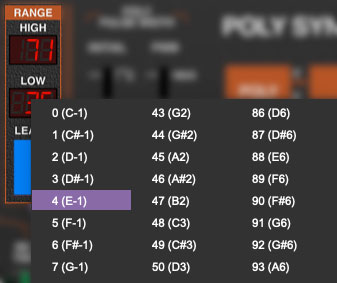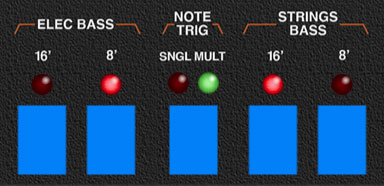
The Bass section consists of a one-oscillator, monophonic synth, that is, it can play one note at a time. It is always low-note priority, which generally works well, because you're typically holding down the bass note with your left-hand pinky.

Range
On the original instrument, the Bass section range was fixed to play in the lowest two octaves only, but Quadra allows it to play in any keyboard region depending on the current Range settings.
Key Range specifies the MIDI note range the bass section will respond to. When combined with the Strings, Poly Synthesizer, and Lead Synthesizer sections, the split and layer options are endless.
Learn button and Low/High displays- There are two ways to set the keyboard range. The quickest way is via the Learn button:
Click the Learn button; the number in the Low display flashes. Hit the lowest keyboard note you'd like the voice to respond to. The number in the High display will now flash; hit the highest note you'd like the voice to respond to. The key range is now set and learn mode is disabled. If you make a mistake, simply repeat the process.

Key range can also be set by clicking on the Low or High LED numeral displays and selecting the desired note number.
When in the flashing learn mode, the high note can also be selected by clicking the High LED numeral display and selecting a MIDI note number; once a note is selected, Quadra will exit learn mode. This can be useful if you'd like to set a top note that's higher than your MIDI controller's highest note.
Elec Bass / Decay- Sets the envelope decay time for the Elec Bass sound. Attack is always instantaneous.
Elec Bass / Resonance- Sets the amount of filter resonance for the Elec Bass sound.
Octave- This slide switch transposes the Elec Bass and Strings bass waves up or down an octave from nominal pitch.
String Bass Volume- Sets the level of the Strings Bass wave routed to the Strings section. Remember that the Strings Bass wave is not routed to the Output Mixer Bass slider - it goes “through” the Strings section, and gets controlled by the Output Mixer Strings slider (indicated by the horizontal arrow over to the Strings section). In this way, the always-on-under-the-hood strings String Chorus Generator gets applied to the Strings Bass waveform for string-machine goodness.
(The String Chorus Generator we're referring to is separate from the Chorus/Flanger effect in the bottom row. More about it in the Strings section.)
The Strings Bass wave is unaffected by the Bass section Decay and Resonance sliders. However, it is affected by the Strings section EQ, Attack, and Release sliders. We know this is a little funky, but that's how the original Quadra works - the idea was that you'd the Elec Bass for rock/jazz/etc., or the Strings Bass for orchestral bowed string section-type sounds.
This is also goes for routing to the effects in bottom row - use the effects' inputs Strings buttons to route the Strings Bass wave to effects.
Buttons

Elec Bass range buttons- These buttons select the current octave range for the bass sawtooth wave, displayed in standard organ footages. One or both footage settings may be active at any time.
Note Trig / Single/Multi- Because the Bass section can only play a single note at a time, Note Trig affects how the envelope generator responds if a note is currently playing and a second note is played.
Single- If a note is currently playing and an additional note is played, any new notes played do not restart the envelope.
Multiple- If a note is currently playing and an additional note is played, any new notes played reset the envelope to the beginning.
In case you a skip-a-doodled the intro of this section, the Bass synth is low-note priority, that is, if multiple notes are played, the lowest one is always heard.
Strings Bass range buttons- These buttons select the current octave range for the Strings Bass wave, displayed in standard organ footages. One or both footage settings may be active at any time.